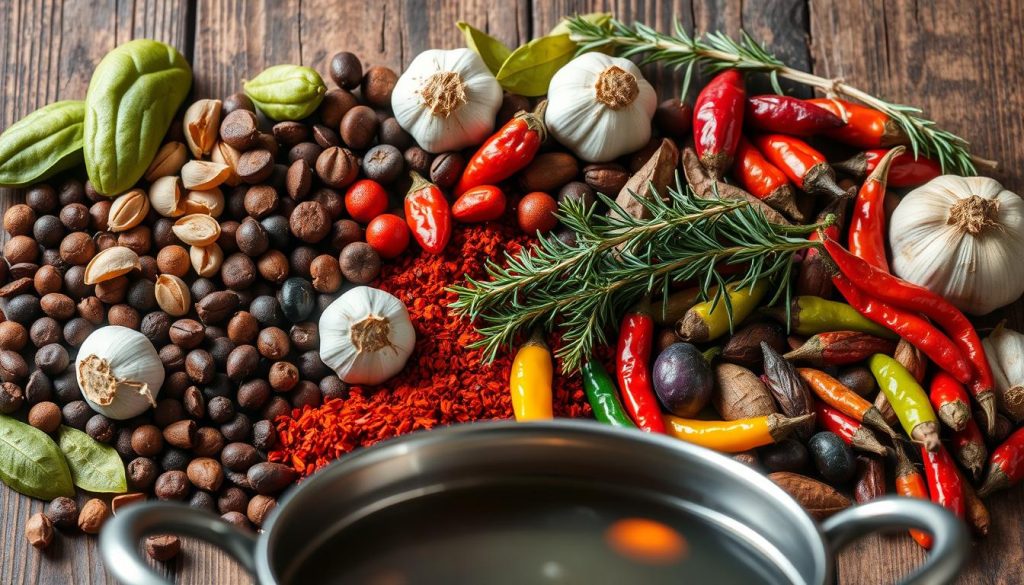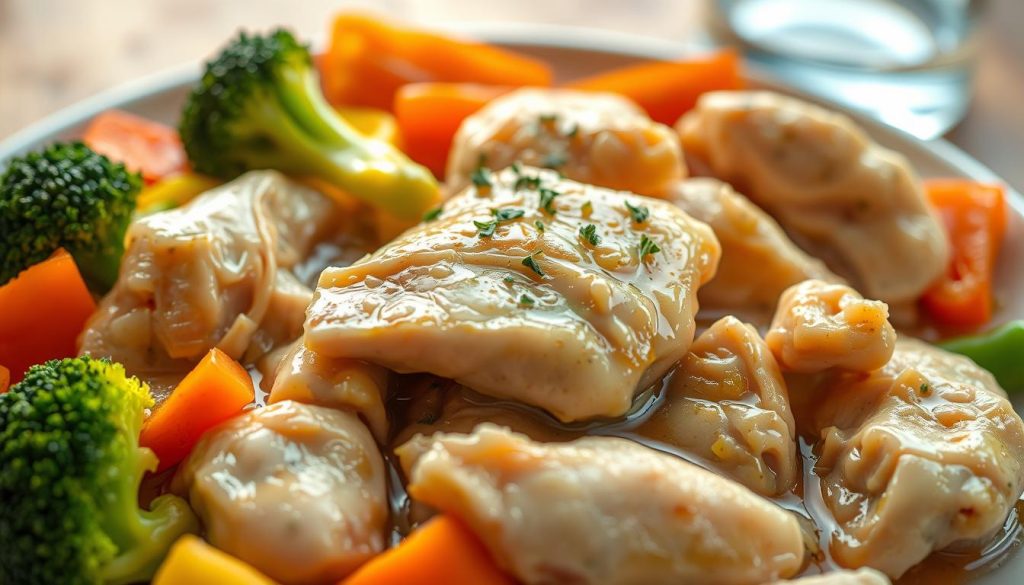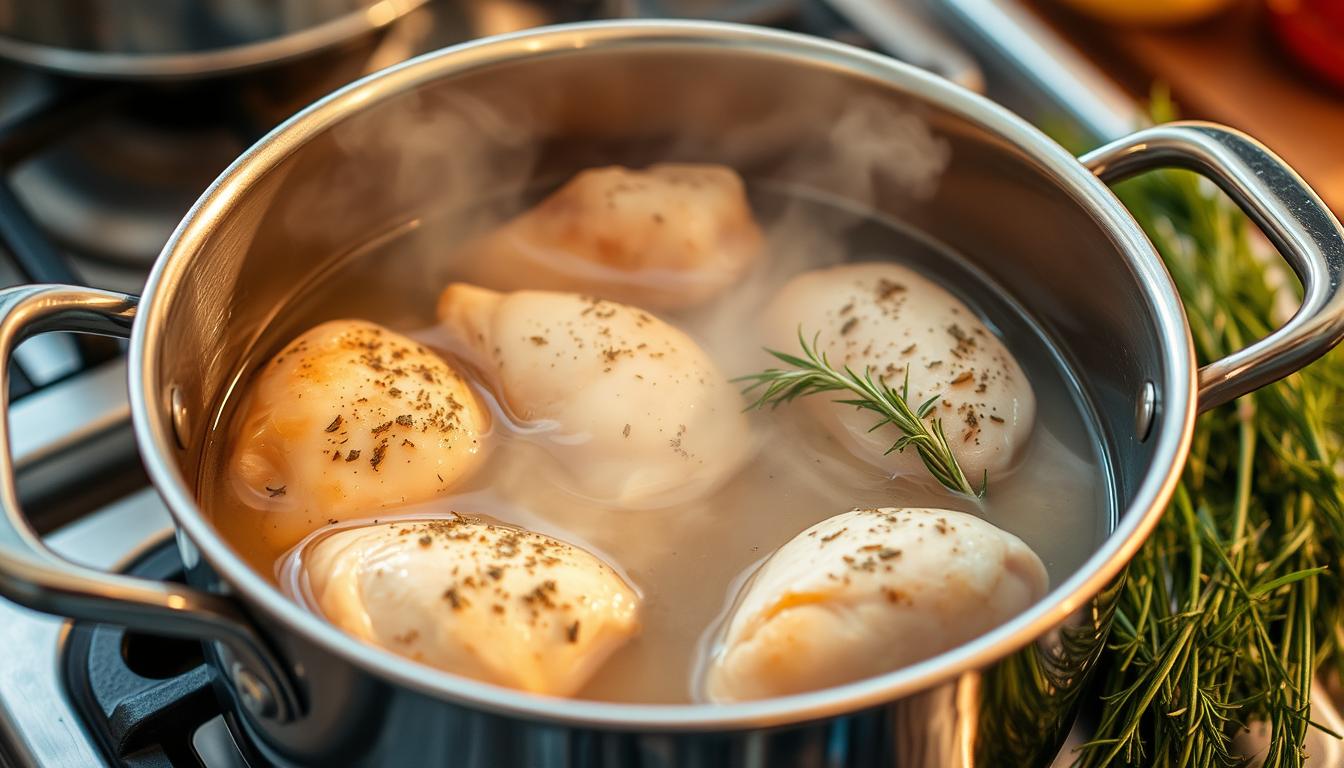Cooking chicken on the stove with water is easy and effective. It makes the chicken juicy, tender, and full of flavor. This method is perfect for those who want a simple way to cook or are looking to try something new. In this guide, you’ll learn how to cook chicken on the stovetop with water. This will help you make delicious and healthy meals with little effort.
Key Takeaways
- Discover the easy and foolproof method for cooking chicken on the stove with water
- Learn how to achieve juicy, tender, and flavorful chicken every time
- Explore the benefits of this hands-off cooking technique for busy weeknights
- Gain valuable tips and tricks for seasoning and flavoring your chicken
- Understand the importance of choosing the right chicken cuts for optimal results
How to Cook Chicken on the Stove with Water
Cooking chicken on the stove with water is easy and effective. It makes the chicken juicy and full of flavor. This method is great for cooks of all levels. It’s perfect for a quick weeknight meal or a special dish.
Preparing the Ingredients
To start, you need a few things:
- Chicken (breasts, thighs, or a mix)
- Water
- Salt and pepper (or your favorite spices)
Make sure the chicken is dry and seasoned. You can use salt, pepper, or other spices. Having everything ready makes cooking easier.
Step-by-Step Instructions
- Put the chicken in a big skillet or saucepan. Add water to cover it.
- Heat the water to boil, then lower the heat to a simmer.
- Cover the pan and cook for 15-20 minutes. The chicken should be 165°F (74°C) inside.
- Take the chicken out of the water and let it rest for a few minutes before eating.
Cooking chicken in water on the stovetop keeps it juicy. It’s a simple way to make a delicious, comforting meal. It’s great for busy nights or when you want something homemade.
Advantages of Cooking Chicken with Water
Cooking chicken with water on the stove has many benefits. It’s a healthier way to cook and makes cleanup easy. These reasons make water-based chicken cooking a great choice for home cooks.
One big benefit of cooking chicken in water is a healthier meal. Water-based cooking keeps the chicken’s juices and nutrients in. It also uses less fat or oil, making it a leaner option.
- Preserves natural juices and nutrients in the chicken
- Requires less added fat or oil, resulting in a healthier dish
- Allows for easy infusion of flavors through the cooking liquid
Another pro of water-based chicken cooking is how easy it is to clean up. Since the chicken cooks in liquid, there’s less splatter or grease. This makes cleanup quick and easy, perfect for busy weeknights.
One of the best reasons to cook chicken in water is the flavor it adds. You can add herbs, spices, or other flavors to the cooking liquid. This lets you customize the taste of your chicken to your liking.
“Cooking chicken in water is a simple yet effective way to ensure your meals are both delicious and nourishing.”
In conclusion, cooking chicken with water on the stove has many benefits. It’s good for your health, easy to clean up, and lets you try new flavors. Water-based chicken cooking is a versatile and practical method for home cooks.
Choosing the Right Chicken Cuts
Choosing the right chicken cuts is key when cooking with water on the stove. Different parts of the chicken can change the texture and taste of your dish. Knowing the differences can help you pick the best cuts for water cooking.
Breast vs. Thighs
Chicken breasts are lean and versatile, but they can dry out quickly in water. Chicken thighs, on the other hand, are juicier and more flavorful. Their higher fat content keeps the meat moist and tender while simmering.
Bone-in or Boneless
Bone-in chicken, like drumsticks and thighs, is great for water cooking. The bones add flavor and moisture, making the meat more succulent. Boneless chicken can dry out, but it works if you watch the cooking time and method.
| Chicken Cut | Best for Water Cooking | Considerations |
|---|---|---|
| Chicken Breast | Moderate | Tends to dry out easily, but can work if monitored closely |
| Chicken Thighs | Excellent | Retains moisture and flavor well during simmering |
| Bone-in Chicken | Excellent | Adds extra flavor and moisture to the dish |
| Boneless Chicken | Good | Can become dry if not monitored closely |
Choosing the right chicken cuts for cooking in water ensures moist and flavorful dishes. Try different which chicken parts to use for water cooking to find your favorite. Whether you prefer bone-in vs boneless chicken, you’ll find the perfect option.
Seasoning and Flavoring Options
Seasoning and flavoring are key when cooking chicken in water. The right mix of herbs, spices, and other ingredients can make a simple dish into a tasty treat. Let’s look at some top flavor ideas for water-cooked chicken and the best spices and herbs for chicken in water.
Adding aromatic herbs to the cooking water is an easy way to flavor your chicken. Fresh herbs like rosemary, thyme, sage, and parsley add a great smell and taste. Just add a few sprigs to the water and let it simmer.
For a stronger flavor, try spices like garlic powder, onion powder, paprika, cumin, or ground black pepper. You can add these to the water or rub them on the chicken before cooking. The trick is to find the right amount so the how to season chicken cooked in water brings out the best flavors without being too much.
| Herb or Spice | Flavor Profile | Suggested Pairing |
|---|---|---|
| Rosemary | Earthy, pine-like | Chicken breasts or thighs |
| Thyme | Minty, lemony | Whole chicken or chicken legs |
| Garlic Powder | Savory, pungent | Chicken drumsticks or wings |
| Paprika | Warm, slightly sweet | Chicken breasts or thighs |
There are countless ways to flavor water-cooked chicken. Try mixing different herbs, spices, and even citrus zest or juice. With a bit of creativity and a good spice collection, you can make your water-cooked chicken truly special.

Time-Saving Tips for Busy Weeknights
Cooking chicken on the stove with water is quick and easy for busy weeknights. To save time, it helps to have meal prep strategies. Let’s look at some tips to make your cooking faster and get a tasty chicken dish ready quickly.
Meal Prep Strategies
Preparation is key for quick weeknight meals. Start by prepping your chicken ahead of time. Buy boneless, skinless chicken breasts or thighs and freeze them until you’re ready. Then, thaw the chicken in the fridge overnight before cooking.
Another tip is to chop your vegetables in advance. Chop onions, carrots, celery, and other veggies a day or two before. Store them in the fridge, ready to add to your chicken dishes.
Consider batch cooking your chicken to save even more time. Cook extra chicken while you’re at it. This way, you’ll have cooked chicken for quick meals or meal prep all week.
| Meal Prep Tip | Time Saved |
|---|---|
| Freeze chicken in advance | 10-15 minutes |
| Chop vegetables ahead of time | 5-10 minutes |
| Batch cook chicken | 20-30 minutes |
By using these meal prep tips, you can cut down your cooking time. Enjoy quick, water-cooked chicken recipes even on the busiest weeknights.
Nutritional Benefits of Chicken Cooked with Water
Cooking chicken with water is a simple yet powerful way to boost its nutritional value. This method cuts down on fat and calories. It also keeps the chicken’s natural goodness intact.
One key benefit is the reduced fat content. As the chicken cooks in water, the fat melts away. This makes the chicken leaner and healthier. It’s great for those watching their weight or cholesterol levels.
Also, water-cooked chicken has fewer calories than fried or baked chicken. This is good for anyone watching their calories or wanting to eat healthier.
Moreover, cooking chicken in water preserves natural nutrients. It keeps the important vitamins, minerals, and proteins in the meat. This means you get more nutritional value from your chicken.
If you want to add more health benefits of chicken cooked in water, nutritional value of water-cooked chicken, and why cooking chicken in water is healthy to your diet, try this method. It’s a smart way to enjoy tasty chicken while making your meals healthier.

Troubleshooting Common Issues
Cooking chicken on the stove with water is usually easy. But, sometimes you might face issues like dry or rubbery chicken. Don’t worry, with some tips, you can fix these problems and get perfectly cooked chicken every time.
Preventing Dry or Rubbery Texture
One common issue is when chicken turns out dry or rubbery. This often happens if it’s cooked too long or at too high a heat. Here are some tips to help you avoid this:
- Choose boneless, skinless chicken breasts or thighs. Chicken with bones and skin can dry out more easily.
- Cook the chicken at a gentle simmer, not a rolling boil. Boiling too fast can make the chicken tough and dry.
- Watch the cooking time closely. Chicken breasts need 12-15 minutes, while thighs take 18-22 minutes.
- Use a meat thermometer to check if the chicken is at 165°F (74°C) before taking it out of the water.
- Let the chicken rest for 5-10 minutes before slicing or shredding. This helps the juices spread evenly.
By using these troubleshooting tips for water-cooked chicken, you can avoid dry or rubbery chicken. You’ll get juicy, tasty chicken every time.
Creative Ways to Use Leftover Chicken
Don’t let leftover chicken go to waste! This section has many tasty ideas for using water-cooked chicken. You can make everything from hearty salads and tasty sandwiches to comforting soups and casseroles. Learn how to turn your extra chicken into delicious meals that everyone will love.
One easy way to use leftover chicken is in a fresh salad. Shredded or diced chicken is great in a Caesar salad. Or, try a Southwest salad with black beans, corn, and chipotle dressing. For something more filling, make a chicken salad sandwich with mayonnaise, celery, and your favorite seasonings.
Chicken soup is a classic choice for leftover chicken. The water-cooked chicken is perfect with a fragrant broth, veggies, and noodles or rice. You can also make a comforting pot pie or a creamy chicken and rice casserole. Both are great for family meals.

